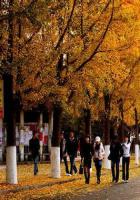To protect its foliage from being eaten by hungry cattle, the rose goes armed into the battle of life with curved, sharp prickles, not true thorns or modified branches, but merely surface appliances which peel off with the bark.To destroy crawling pilferers of pollen, several species coat their calices, at least, with fine hairs or sticky gum; and to insure wide distribution of offspring, the seeds are packed in the attractive, bright red calyx tube or hip, a favorite food of many birds, which drop them miles away.When shall we ever learn that not even a hair has been added to or taken from a blossom without a lawful cause, and study it accordingly? Fragrance, abundant pollen, and bright-colored petals naturally attract many insects;but roses secrete no nectar.Some species of bees, and a common beetle (Trichius piger) for example, seem to depend upon certain wild roses exclusively for pollen to feed themselves and their larvae.Bumblebees, to which roses are adapted, require a firmer support than the petals would give, and so alight on the center of the flower, where the pistil receives pollen carried by them from other roses.Although the numerous stamens and the pistils mature simultaneously, the former are usually turned outward, that the incoming pollen-laden insect may strike the stigma first.When the large bees cease their visits as they may in long-continued dull or rainy weather, the rose, turning toward the sun, stands more or less obliquely, and some of the pollen must fall on its stigma.Occasional self-fertilization matters little.
If plants have insect benefactors, they have their foes as well and hordes of tiny aphids, commonly known as green flies or plant lice, moored by their sucking tubes to the tender sprays of roses, wild and cultivated, live by extracting their juices.Acurious relationship exists between these little creatures and the ants, which "milk" them by stroking and caressing them with their antennae until they emit a tiny drop of sweet, white fluid.
The yellow ant, that lives an almost subterranean life, actually domesticates flocks and herds of root-feeding aphids; the brown ant appropriates those that live among the bark of trees; and the common black garden ant (Lasius niger), devoting itself to the aphis of the rose bushes, protects it in extraordinary ways, delightfully described by the author of "Ants, Bees, and Wasps."In literature, ancient and modern, sacred and profane, no flower figures so conspicuously as the rose.To the Romans it was most significant when placed over the door of a public or private banquet hall.Each who passed beneath it bound himself thereby not to disclose anything said or done within; hence the expression sub rosa, common to this day.
The PRAIRIE, CLIMBING, or MICHIGAN ROSE (R.setigera) lifts clusters of deep, bright pink flowers, that after a while fade almost white, above the thickets and rich prairie soil, from southern Ontario and Wisconsin to the Gulf, as far eastward as Florida.Its distinguishing characteristics are: Stout, widely separated prickles along the stem, that grows several feet long;leaves compounded of three, rarely five, oval leaflets, acute or obtuse at the apex; stalks and calyx often glandular; odorless flowers that, opening in June and July, measure about two and a half inches across, their styles cohering in a smooth column on which bees are tempted to alight; and a round hip, or seed vessel, formed by the fruiting calyx, which is more or less glandular.From this parent stock several valuable double-flowering roses have been derived, among others the Queen and the Gem of the Prairies, but it is our only native rose that has ever passed into cultivation.
The SMOOTH, EARLY, or MEADOW ROSE (R.blanda), found blooming in June and July in moist, rocky places from Newfoundland to New Jersey and a thousand miles westward, has a trifle larger and slightly fragrant flowers, at first pink, later pure white.Their styles are separate, not cohering in a column nor projecting as in the climbing rose.This is a leafy, low bush mostly less than three feet high; it is either entirely unarmed, or else provided with only a few weak prickles; the stipules are rather broad, and the leaf is compounded of from five to seven oval, blunt, and pale green leaflets, often hoary below.
In swamps and low wet ground from Quebec to Florida, and westward to the Mississippi, the SWAMP ROSE (R.Carolina) blooms late in May and on to midsummer.The bush may grow taller than a man, or perhaps only a foot high.It is armed with stout, hooked, rather distant prickles, and few or no bristles.The leaflets, from five to nine, but usually seven, to a leaf, are smooth, pale, or perhaps hairy beneath to protect the pores from filling with moisture arising from the wet ground.Long, sharp calyx lobes, which drop off before the cup swells in fruit into a round, glandular, hairy red hip, are conspicuous among the clustered pink flowers and buds.
Surely no description of our COMMON, LOW, DWARF, or PASTURE ROSE(R.humilis; R.lucida of Gray) is needed.One's acquaintance with flowers must be limited indeed, if it does not include this most abundant of all the wild roses from Ontario to Georgia, and westward to Wisconsin.In light, dry, or rocky soil we find the exquisite, but usually solitary, blossom late in May until July, and, like most roses, it has the pleasant practice of putting forth a stray blossom or two in early autumn.The stamens of this species are turned outward so strongly that self- pollination must very rarely take place.















